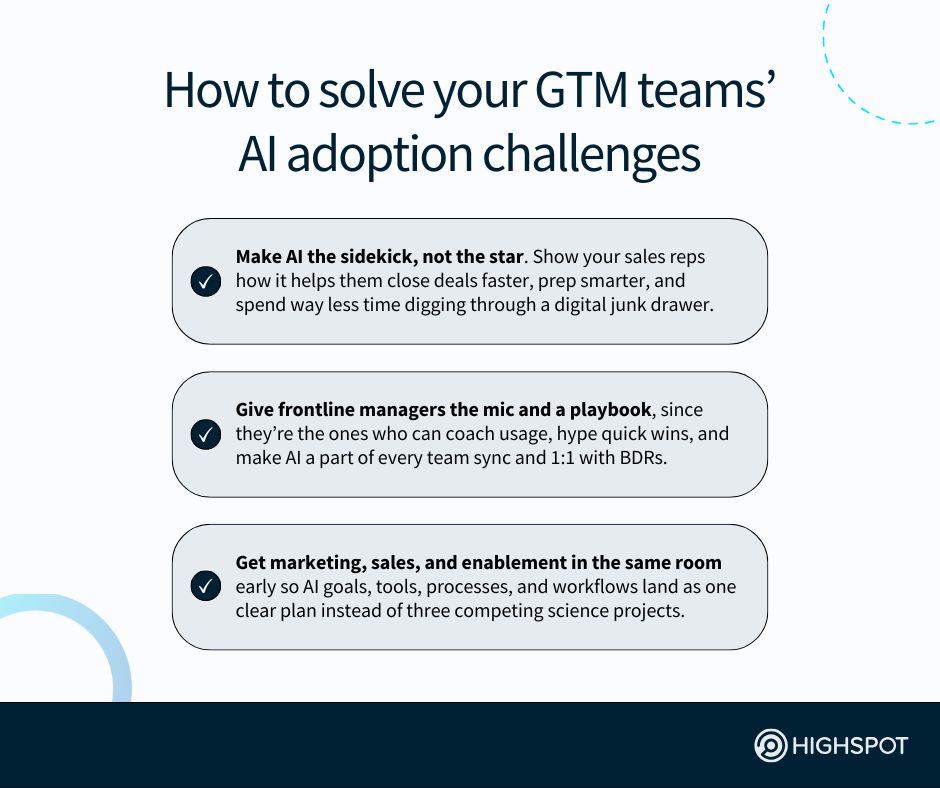Key Takeaways
- Resolving your go-to-market (GTM) organisation’s artificial intelligence (AI) adoption challenges requires embedded workflows, clear ownership, and consistent manager-led reinforcement.
- Whether you’re investing in GenAI point solutions or agentic platforms like Highspot, aligning AI use to real GTM initiatives is what drives lasting behaviour change and measurable business impact.
- Once reps, marketers, and enablement specialists buy in, they can execute with greater speed, precision, and accountability and rely on AI to support decisions that move your business forward.
It’s no secret that ensuring complete AI adoption for sales, marketing, and enablement teams is a tough task for B2B go-to-market leaders today.
(Even those at companies with all the optimal talent and AI technologies in place.)
Every enterprise hits the same wall: getting teams to use the tools consistently.
Implementing ROI-improving AI systems as part of your company’s broader digital transformation efforts requires a clear plan, shared ownership, and tight execution across teams. No org nails this on instinct. In fact, the top GTM leaders build a dedicated framework to guide AI tool use from day one.
In other words, go-to-market leaders like you are driving AI adoption by helping each GTM business unit embed artificial intelligence into their daily workflows and shared initiatives so they can execute smarter, faster, and with autonomy.
That said, follow-through is everything—and the GTM leaders that follow these tried-and-true best practices tied to AI adoption are the ones that win (read: see their teams take full advantage of the cutting-edge technology).
5 AI adoption challenges that go-to-market teams are seeing today
Organisations struggle with not only the adoption of AI but also the use of AI.
“With transformational technologies, there are always gaps between the pace of technological change and the ability of individuals, businesses and policymakers to keep up,” Deloitte’s 2024 State of Generative AI Report explains.
“GenAI is no exception,” the report continued.
There may be high demand among BDRs, marketers, and enablement personnel to use the tech to streamline operations, reduce costs, and deliver better customer experiences. But without addressing these common challenges artificial intelligence presents, AI continues to remain elusive for enterprise GTM teams.
Put another way?
They know agentic and generative AI solutions can help go-to-market business functions work together to accelerate revenue growth—but these companies also recognise they need to remove blockers before adopting AI systems.

1. If AI tools are disconnected from workflows, it makes frontline adoption nearly impossible
When adopting AI tools, most teams start strong. If those platforms don’t ‘speak’ with existing ones, though, reps still have to jump between five tabs to get a single answer.
That’s where momentum fades and manual habits take back over.
If your chosen AI technologies don’t integrate seamlessly with existing systems in your sales technology stack, they’ll collect dust sooner than later.
For instance, if your AI assistant lives outside of your CRM, inbox, or content tools, your frontline teams won’t use it, no matter how powerful it is on paper.
Simply put, your business needs AI that fits into reps’ flow of work.
2. Artificial intelligence only creates ‘noise,’ when it’s not tied to GTM execution signals
Machine learning can do a lot, but if it’s trained on outdated, irrelevant, or low-signal customer data, you’re left with auto-generated insights that confuse more than they help. Without tying AI to your GTM strategy, the output feels random, not useful.
For example, an AI tool surfacing the same five content pieces to every seller won’t help your go-to-market organisation prioritise what matters most. If your team doesn’t trust the recommendations, they’ll stop checking them altogether.
“If AI lives in another platform, tab, or tool, it just becomes more noise and more steps,” Highspot Revenue Enablement Leader Annie Lizenbergs shared in Highspot’s GTM Performance Gap Report. “Reps won’t use what disrupts their flow. They’ll ignore it. It becomes out of sight, out of mind.”
3. Sales and enablement leaders struggle to prove business impact from current AI use
You’ve invested in advanced AI solutions, but your sales dashboard’s still blank, and the board still asks what you’ve shipped. Sound familiar? That’s because most AI tools are better at producing activity than driving aligned, measurable outcomes.
If you can’t connect the use of artificial intelligence to your sales process, team performance, or revenue benchmarks, your AI spend stays stuck in the ‘experimental’ bucket. Enablement content creation and curation might get faster, but unless it’s linked to execution, it won’t mean much.
4. Even strong AI use cases can stall without clear change management and ownership
Exhaustive AI adoption across go-to-market requires more than a tool launch. It also needs concrete structure, accountability, and executive air cover.
When it’s unclear who owns AI activation and the tracking of eventual usage and performance KPIs, it drops to the bottom of everyone’s to-do list. Teams may experiment with features, but without a champion, utilisation stays low.
For example, without someone steering how AI supports sales onboarding, training, or sales enablement, it never becomes embedded into programmes. An AI tech stack that lacks defined ownership won’t scale because your GTM employees won’t know when or how to use the technology to drive impact.
5. Go-to-market teams need training to turn artificial intelligence into daily behaviour
Hand someone a new AI tool with natural language processing and machine learning capabilities, and you’ll get curiosity for a week. But then you’ll get silence. Employees across your GTM organisation need time, reps, and guidance to use AI effectively and learn how it can boost their sales efficiency and productivity.
Just like with any new tool, skills need to be built and reinforced.
Using AI to complete tasks like deal prep, content lookup, or training personalisation can save time, but only if reps know when and why to engage with it. Generative AI doesn’t magically teach itself. It needs training, practice, and feedback to stick.
| Element required for successful AI adoption at enterprises | Why it matters |
|---|---|
| Change management | Organisations regularly underestimate the effort of implementing AI, but a clear change plan ensures AI systems don’t stall after rollout and keeps teams aligned as your technologies evolve. |
| Dedicated AI champion | A visible leader helps drive cross-functional AI adoption and accountability, giving each business function in GTM a reason to engage, participate, and make AI a part of their day-to-day workflow. |
| Best-in-class AI talent | You need experts who can build, evaluate, and scale AI responsibly. Without deep in-house knowledge, your AI strategy carries risks and puts too much pressure on your information technology team. |
| AI skills training resources | Your teams can’t unlock AI value unless they’re equipped to use it. You need programmes that train, equip, guide, and coach reps over time, especially where AI supports ongoing rep development. |
| Structured AI governance | Governance defines how artificial intelligence behaves across the org, limits risks, and keeps AI initiatives aligned with strategy. It ensures AI decisions are tied to measurable metrics. |
| Data security compliance | Every team handling AI tools needs to comply with data privacy measures. Without that foundation, even the best tools expose your business to unnecessary regulatory and reputational risk. |
| Relevant data utilisation | Feeding your AI technologies the wrong data is a fast track to failure. Prioritise accuracy to avoid data quality issues and ensure your tools produce outputs your GTM teams trust and use. |
| AI analyst (GTM ops) | A dedicated RevOps analyst helps analyse, measure, and optimise how AI is used across teams. They track what’s working and help evolve your AI systems based on performance data. |
| Generative AI alignment | Generative AI needs a clear purpose, not just access to data. When deployed strategically, it can act as virtual assistants for GTM teams, completing routine tasks and accelerating execution. |
How GTM leaders at large companies boost AI adoption among their teams
As Forrester Chief Research Officer Sharyn Leaver recently noted, success with AI adoption “hinge[s] on investing in AI governance, balancing human expertise with AI tools, and empowering teams to deliver clear, validated outcomes.”
Follow these proven approaches, and you’ll see adoption rates rise.
Involve frontline GTM managers early so they can reinforce AI utilisation in the field
Managers are closest to reps. Their influence can make or break daily AI use. Get them involved from the start to help connect tools to real business needs. When sales directors reinforce usage (ironically) with AI-powered sales coaching tools, like the one offered by Highspot, BDRs are more likely to keep showing up.
Make AI adoption a leadership-led initiative, not merely a technology rollout from IT
When AI is positioned as “just another tool from IT,” it hardly ever sticks. But when execs frame it as critical to company strategy, teams take notice. Visibility from senior leadership validates the effort and sets the tone for cross-functional alignment.
Lead with real-world workflows that can drive AI performance for each GTM team
Your AI only has the intended impact when it makes everyday work easier. Focus first on workflows your teams already know: deal prep, lead follow-up, or campaign planning. Show how the use of AI for sales, marketing, and enablement improves what they already do, not what you hope they’ll do someday.
Incentivise early AI usage with recognition, rewards, or spotlights in team meetings
Getting started is often the hardest part for go-to-market teams. So, make it fun, visible, and worth it. Whether it’s a shoutout in Slack or a coffee card for ‘most AI assists,’ small wins build momentum. Public recognition validates early adopters and gives everyone else in GTM an AI adoption ‘nudge.’
Show each business function how AI can strengthen and speed up decision-making
Every team wants faster answers, to make better decisions, and less spinning. Map AI capabilities to each team’s daily choices, blockers, processes, and lag time. Whether it’s surfacing top-performing content used in sales plays or scoring deals, AI thrives when it makes choices simpler and smarter for GTM.
Relay how generative AI can be a force multiplier for content, training, and coaching
Many organisations overlook how much time goes into rep prep, onboarding, and enablement. Generative AI for sales, marketing, and enablement teams can help them build collateral, secure feedback, and surface insights.
Note how AI research can save sales, marketing, and enablement hours each week
Too much time is spent searching across folders and docs just to prepare for a single meeting. With a sales enablement platform like Highspot at the heart of your GTM tech stack, you can conduct AI-powered research to help reps find answers fast and marketers and enablement specialists locate insights on demand.
Your AI adoption questions, answered
Trust us when we say that you’re not the only go-to-market organisation navigating AI adoption hurdles. We hear the same questions from GTM leaders often.
Here are answers to commonly asked questions about rolling out AI across sales, marketing, and enablement teams (and tracking performance over time).
Which AI tools can go-to-market teams adopt with ease today to drive performance?
Go-to-market teams are adopting AI platforms like Highspot that embed AI sales agents and real-time deal intelligence into workflows across content, training, coaching, and buyer engagement. The Highspot services and support staff aids GTM leaders and their technical teams with implementation to ensure AI adoption feels straightforward, low-lift, and seamlessly integrated into existing workflows.
How can I get sales reps to use artificial intelligence tools in their daily workflows?
Sales reps engage when AI tools support what they’re already doing, including prepping for calls, personalising content, or finding fast answers in your CRM system or their inbox. The key is embedding AI where reps already work and connecting usage to things they care about, such as sales quota attainment.
What are some best practices for creating an AI adoption framework for my teams?
You need a dedicated owner, clear revenue enablement plan, and aligned success metrics tied to business goals in addition to software-rollout checklists. Strong frameworks connect AI to strategic programmes, assign team responsibilities, and include manager-led reinforcement as part of daily execution.
How do we drive AI adoption without overwhelming teams with more tools and noise?
Incorporate artificial intelligence in sales and marketing workflows instead of asking your teams to adopt standalone apps or dashboards. Usage grows when AI shows up at the right moment with something useful, like surfacing key plays and messaging before a meeting or flagging a coaching opportunity.
What kinds of AI use cases deliver the most immediate value for sales and marketing?
Sales and marketing teams benefit most from AI that accelerates prep, personalises assets, and helps surface the next-best action in active deals. Anything that saves GTM teams time and reduces context switching, like content recommendations, buyer insights, or campaign performance, leads to a fast ROI.
How do we measure if our AI investments are actually improving GTM performance?
You need to connect AI adoption and utilisation with business outcomes, rep productivity, training completion, content deployment, and buyer engagement. Look for impact on performance trends, reduced manual lift, and how often teams rely on AI to guide execution versus falling back on manual work.
What KPIs should we use to track progress on AI usage across go-to-market teams?
Track activity completion (e.g., training, pitching, coaching), time savings, and performance trends by team, role, and initiative. You’ll want visibility into usage patterns by workflow so you can see where AI is helping and where you may need more enablement or tuning to enhance your GTM teams’ AI maturity level.
How do we align AI adoption across sales, marketing, and enablement without silos?
Build a shared AI charter across go-to-market functions that includes what it solves for, who owns which tools and processes, and how progress will be measured. When teams collaborate on AI use cases tied to joint initiatives, adoption becomes a shared success metric and North Star for teams to follow.
What are the most common reasons AI adoption fails to stick, and how do we avoid them?
Most efforts stall when AI systems aren’t linked to current workflows, owned by a dedicated team, or reinforced by frontline leaders in revenue and go-to-market operations. Avoid the stall-out by treating AI adoption like any strategic initiative, with owners, training, measurable goals, and accountability baked in.




